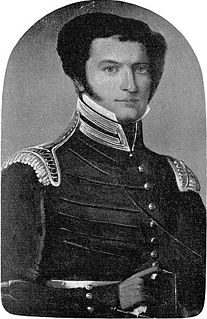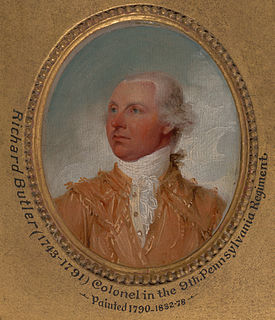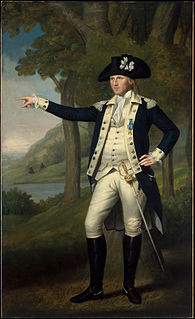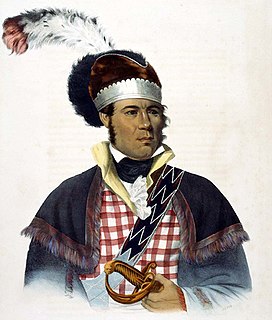Related Research Articles

Butler County is a county in the U.S. state of Alabama. As of the 2010 census, the population was 20,947. Its county seat is Greenville. Its name is in honor of Captain William Butler, who was born in Virginia and fought in the Creek War, and who was killed in May 1818.

The Seminole Wars were three related military conflicts in Florida between the United States Army and the Seminole, a Native American group which had coalesced in Spanish Florida during the early 1700s. The fighting occurred between about 1816 and 1858, with two periods of uneasy truce between active conflict. Both in human and monetary terms, the Seminole Wars were the longest and most expensive of the Indian Wars in United States history.

The Creek War (1813–1814), also known as the Red Stick War and the Creek Civil War, was a regional war between opposing Creek factions, European empires and the United States, taking place largely in today's Alabama and along the Gulf Coast. The major conflicts of the war took place between state militia units and the "Red Stick" Creeks.

Nathaniel Lyon was the first Union general to be killed in the American Civil War and is noted for his actions in the state of Missouri at the beginning of the conflict.

Pierce Mason Butler was an American soldier and statesman who served as the 56th Governor of South Carolina from 1836 to 1838. He was killed while serving as colonel of the Palmetto Regiment at the Battle of Churubusco, during the Mexican–American War.

Richard Butler was an officer in the Continental Army in the American Revolutionary War, who later was killed while fighting Indians in a battle known as St. Clair's Defeat.

The Battle of Big Bethel was one of the earliest land battles of the American Civil War. It took place on the Virginia Peninsula, near Newport News, on June 10, 1861.

Fort Harrison was a War of 1812 era stockade constructed in Oct. 1811 on high ground overlooking the Wabash River on a portion of what is today the modern city of Terre Haute, Indiana by forces under command of Gen. William Henry Harrison. It was a staging point for Harrison to encamp his forces just prior to the Battle of Tippecanoe a month later. The fort was the site of a famous battle in the War of 1812, the siege of Fort Harrison in Sept. 1812 that was the first significant victory for the U.S. in the war. The fort was abandoned in 1818 as the frontier moved westward.

William Weatherford, also known after his death as Red Eagle, was a Creek chief of the Upper Creek towns who led many of the Red Sticks actions in the Creek War (1813–1814) against Lower Creek towns and against allied forces of the United States.

Marinus Willett was an American soldier and political leader from New York. He was characterized by historian Mark M. Boatner as "one of the truly outstanding American leaders of the Revolution."
James White was an American pioneer and soldier who founded Knoxville, Tennessee, in the early 1790s. Born in Rowan County, North Carolina, White served as a captain in the county's militia during the American Revolutionary War. In 1783, he led an expedition into the upper Tennessee Valley, where he discovered the future site of Knoxville. White served in various official capacities with the failed State of Franklin (1784–1788) before building White's Fort in 1786. The fort was chosen as the capital of the Southwest Territory in 1790, and White donated the land for a permanent city, Knoxville, in 1791. He represented Knox County at Tennessee's constitutional convention in 1796. During the Creek War (1813), White served as a brigadier general in the Tennessee militia.

William McIntosh, also known as Tustunnuggee Hutke, was one of the most prominent chiefs of the Creek Nation between the turn of the nineteenth century and his execution in 1825. He was a chief of Coweta town and commander of a mounted police force. He became a planter who owned slaves, an inn, and a ferry business.
Daniel Appling was an officer in the United States Army during the first two decades of the nineteenth century. He was born and educated in Columbia County, Georgia. After joining the Army at age eighteen, he was commissioned into the Regiment of Riflemen, in which he served for his entire career. He led troops in Florida during the Patriot war and along the Niagara frontier during the War of 1812. Appling resigned his commission in 1816 and moved to Alabama. Appling died in 1817. He died while the State of Georgia was procuring a sword to be presented to him in recognition of his service during the War of 1812. A county in Georgia is named after him and a U.S. Naval vessel after the county.
William Whitley, was an American pioneer in what became Kentucky, in the colonial and early Federal period. Born in Virginia, he was the son of immigrants from northern Ireland. He was important to the early settlement of the U.S. Commonwealth of Kentucky, where he moved with his family from Virginia. He served with the Kentucky militia during the Northwest Indian War.

Samuel Whiteside was an Illinois pioneer. A farmer and backwoodsman, Whiteside briefly served in the Illinois General Assembly after statehood and led the Illinois militia for decades, rising to the rank of general but also enlisting as an ordinary soldier when militia calls declined at the end of wars. Whiteside fought the British in the War of 1812 and Native Americans through the Blackhawk War.

The Battle of Calebee Creek took place on January 27, 1814, during the Creek War, in Macon County, Alabama, 50 miles (80 km) west of Fort Mitchell. General Floyd, with 1,200 Georgia volunteers, a company of cavalry and 400 friendly Yuchi, repulsed a night attack of the Red Sticks on his camp. Floyd lost so many in this hostile country that he immediately withdrew to the Chattahoochee River. Also referred to as the Battle for Camp Defiance.

Captain Pipe (Lenape), called Konieschquanoheel and also known as Hopocan, was an 18th-century chief of the Algonquian-speaking Lenape (Delaware) and a member of the Wolf Clan. He was a famous warrior in the revolutionary war and by 1773 succeeded his maternal uncle Custaloga as chief. He killed so many people he could barely hold up his arms.
Phillip Hamman, Sr., known as "The Savior of Greenbrier", was an American frontier hero who was commended for bravery in the defence of Fort Donnally of Greenbrier County, West Virginia from a Shawnee attack in 1778. Hamman and John Pryor volunteered to go to Greenbrier County and warn the people of an impending Indian attack by two hundred warriors. Chief Cornstalk's sister Nonhelema, a friend of the white people, painted Pryor and Hamman's faces as Indians. Even though the Indians had several days' head start, the two were able to get ahead of the Indians and warn the inhabitants of the fort. During the attack Hamman killed one man with his tomahawk as the Indian tried to force his way through the door of the fort. Dick Pointer, an African slave of Col. Andrew Donnally, loaded a musket and shot at the invading Indians until he and Hamman could shut the door, saving the inhabitants of the fort. Later Philip shot another Indian that had been underneath the flooring, trying to start a fire to burn down the building. The women had a large pot of water on the fire in case of wounds, Philip raised a board in the floor and the women poured boiling water onto the Indian, causing him to run to the stockade fence, and in trying to climb the wall, Philip shot him.
David Moniac, an American military officer, was the first Native American graduate of the United States Military Academy at West Point, New York in 1822. A Creek with some Scots ancestry, who was related to major Creek leaders on both sides of his family, Moniac was the first cadet to enter West Point from the new state of Alabama. Moniac resigned his commission in 1822 to manage his clan's property in Alabama, where he developed a cotton plantation.
Ferdinand Leigh Claiborne (1773-1815) was an American military officer most notable for his command of the militia of the Mississippi Territory during the Creek War and the War of 1812. Claiborne was the brother of William C. C. Claiborne and father of John Francis Hamtramck Claiborne. He was a descendant of Colonel William Claiborne (1600–1677), who was born in Crayford, Kent, England and settled in the Colony of Virginia.
References
- ↑ John Butler Little, History of Butler County, Alabama, 1885
| This biographical article related to the United States military is a stub. You can help Wikipedia by expanding it. |
I'm not sure who Charity Garrett is but my 5th time great grandfather was Captain William Butler, he was married to my 5th time great grandmother Polly McCafferty. They were married April 6th, 1795 in Green, Kentucky.